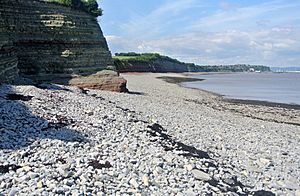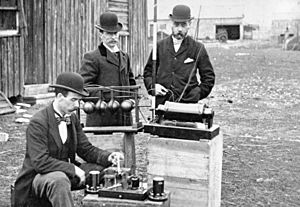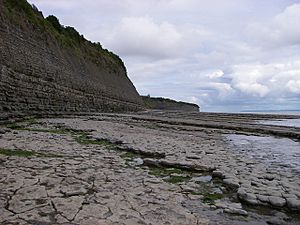Lavernock facts for kids
Quick facts for kids Lavernock
|
|
|---|---|
 Lower Blue Lias rocks exposed at Lavernock Point |
|
| OS grid reference | ST187682 |
| Community |
|
| Principal area |
|
| Ceremonial county | |
| Country | Wales |
| Sovereign state | United Kingdom |
| Postcode district | CF |
| Police | South Wales |
| Fire | South Wales |
| Ambulance | Welsh |
| EU Parliament | Wales |
| UK Parliament |
|
| Welsh Assembly |
|
Lavernock (Welsh: Larnog) is a small village, also called a hamlet, located in the Vale of Glamorgan in Wales. It sits right on the coast, about 7 km (4.3 mi) south of Cardiff. Lavernock is nestled between the towns of Penarth and Sully, and it offers great views of the Bristol Channel.
Contents
Marconi's Amazing Radio Experiment
On May 13, 1897, something truly historic happened at Lavernock Point. A famous inventor named Guglielmo Marconi, who was from Italy but living in Britain, made history. He was helped by George Kemp, an engineer from the Post Office in Cardiff. Together, they sent and received the very first wireless radio signals over open sea.
The signals traveled between Lavernock Point and Flat Holm island. The first message sent in morse code was "ARE YOU READY". This was quickly followed by "CAN YOU HEAR ME". The reply they got back was "YES LOUD AND CLEAR". You can even see the original paper slip with the Morse code for the first message at the National Museum of Wales.
After this first successful chat, they sent more detailed messages. These messages shared information about their equipment settings and how well the sound was coming through. Marconi mentioned he was using a 20 in (510 mm) spark on his equipment.
These successful tests came after several days of trying and failing. They had to make many adjustments to their aerials (antennas). For the rest of the week, they kept testing in different weather conditions and with various settings. Marconi had a lot of support from Mr. William Preece, who was the chief engineer for the Post Office. Preece had even sent radio signals across Coniston Water eight years earlier.
George Kemp, one of the Post Office engineers, kept a detailed diary. He wrote about how Marconi's equipment was first set up on the cliff at Lavernock Point. They used a 30 yd (27 m) high pole with a metal cap on top.
Kemp's diary entry from May 13, 1897, describes a breakthrough:
- "On the 11th and 12th his experiments were unsatisfactory — worse still, they were failures — and the fate of his new system trembled in the balance.
- "An inspiration saved it. On the 13th May the apparatus was carried down to the beach at the foot of the cliff, and connected by another 20 yd (18 m) of wire to the pole above, thus making an aerial height of 50 yd (46 m) in all. Result, The instruments which for two days failed to record anything intelligible, now rang out the signals clear and unmistakable, and all by the addition of a few yards of wire!"
This meant that by simply adding a bit more wire to the antenna, the signals became clear!
The first tests were so successful over the 3+1/3 mi (5.4 km) stretch of water. So, they decided to move the equipment from Flat Holm to Brean Down Fort. This increased the distance to almost 10 mi (16 km) from Lavernock Point.
After these trials, Marconi started his own company, the 'Wireless Telegraph and Signal Company'. This meant he couldn't work with the Post Office engineers anymore. But George Kemp immediately left his job at the Post Office and joined Marconi's new company as the head of engineering.
In 1948, a special bronze plaque was put up to remember these historic radio transmissions. It's located in the courtyard of the old St. Lawrence church in Lavernock. The small stone hut that Marconi used for his experiments is still standing on the cliff edge today.
Lavernock's Past as a Holiday Spot
From the late 1890s until 1968, Lavernock and its nearby bays, St Mary's Well and Swanbridge, were very popular holiday spots. Many day trippers from the South Wales Valleys, Newport, Cardiff, Penarth, and Barry would visit. The beaches were often full of people on weekends and Bank Holidays during the summer.
Hundreds, sometimes thousands, of visitors would enjoy the ice cream parlor, two busy cafes, the Golden Hind public house, and the Lavernock Bay Hotel. Most visitors arrived by steam train, which stopped at Lavernock and Swanbridge Halts on the busy Taff Vale Railway Line.
Lavernock became much quieter after 1968 when the railway line closed down. This happened because of something called the Beeching Axe, which closed many railway lines across Britain. Even though some people started arriving by car, the number of visitors dropped a lot. This meant that the cafes, pub, and even the hotel eventually closed down.
Exploring Lavernock Point
Lavernock Point (Welsh: Trwyn Larnog) is a piece of land that sticks out into the sea on the South Wales coast. From here, you can see across the Bristol Channel to the Somerset Coast.
A line drawn between Lavernock Point and Sand Point, Somerset marks where the Severn estuary ends and the Bristol Channel begins. Because the tides here are very strong, there are powerful currents close to the shore. These currents can reach speeds of over 7 knots (13 km/h) for several hours during each tide.
There have been ideas to build a huge wall, called a Severn Barrage, across the channel from Lavernock Point to Brean Down in Somerset. This wall would use the strong tides to create electricity. These plans are still being discussed.
Rocks and Ancient Creatures
The cliffs along the coast near Lavernock Point show layers of sedimentary rocks. These rocks were formed around 200 million years ago, during the late Triassic and early Jurassic periods. They tell a story of a time when a desert area was covered by the sea.
You can find many fossils of oysters and other sea creatures in these cliffs. In 2015, two brothers, Nick and Rob Hanigan, found an amazing fossilized skeleton. It belonged to a dog-sized theropod dinosaur, which was a "cousin" of the giant tyrannosaurus rex. This new dinosaur was named Dracoraptor hanigan, meaning "dragon robber," in honor of the brothers. Experts called it "the best dinosaur fossil Wales has ever had." You can now see this skeleton at the National Museum Wales in Cardiff.
Lavernock Fort: A Historic Defense
On Lavernock Point, a gun battery called Lavernock Fort was built in the late 1860s. It was finished in 1870 and had three large cannons. These cannons were there to protect the shipping routes into Cardiff and Bristol. Later, more cannons were added, and then they were replaced with faster-firing naval guns.
During the Second World War, two searchlight batteries were added to the fort. These helped protect the ships in the Atlantic. Today, the main part of the gun battery is a protected Ancient Monument. It includes the places where the guns were, observation posts, and living quarters for the soldiers. The main road to Lavernock Point is even called 'Fort Road' to remember it.
Royal Observer Corps Bunker
Just a few yards from Marconi's historic hut, there was a World War II Royal Observer Corps (ROC) searchlight post. It was on the cliff edge, with clear views over the Bristol Channel. The volunteer ROC observers would spot Nazi German Luftwaffe (German air force) raids coming across the channel and warn the town.
In 1962, a protected underground nuclear fallout shelter (or bunker) was built nearby for the ROC. By the 1960s, the ROC had changed from spotting aircraft to working underground. They used instruments to detect nuclear explosions and warn people about radioactive fallout if a nuclear war happened. The volunteers at this post were called into action later that year. They spent almost ten days underground during the Cuban Missile Crisis, as the government prepared for a possible war.
The Penarth cliff top nuclear bunker was closed in 1975 because of repeated break-ins. But you can still see the concrete entrance hatch and ventilator tower near the cliff walk. The Royal Observer Corps itself was disbanded in 1995 after the end of the Cold War.
Lavernock Point Nature Reserve
Lavernock Point is also a special nature reserve. Here, you can find interesting wildlife combined with historical sites. The limestone grassland has many colorful plants like dyer's greenweed, devil's-bit scabious, common spotted orchid, and fleabane. More than 25 different types of butterflies have been seen and recorded here.
Lavernock and the nearby Cosmeston Lakes are important places for migrating birds to land. Many bird migration routes across the Bristol Channel pass through the reserve. The islands of Steep Holm and Flat Holm act as resting spots for these birds. You can see different birds throughout the year, including summer visitors, seabirds, and birds that live there all the time.
The reserve is managed by the Wildlife Trust of South & West Wales. They work to keep a good balance between grassland, scrubland, and woodland at Lavernock Point Reserve.
Monkstone Lighthouse
| Location | Lavernock Bristol Channel Wales United Kingdom |
|---|---|
| Coordinates | 51°24′53″N 3°6′0″W / 51.41472°N 3.10000°W |
| Year first constructed | 1839 (first) |
| Year first lit | 1993 (current) |
| Automated | 1993 |
| Construction | stone tower first-stage, fiberglass tower second-stage |
| Tower shape | two-stages cylindrical tower with double balcony and small lantern |
| Markings / pattern | black lower stage tower, red upper stage tower |
| Height | 23 m (75 ft) |
| Focal height | 13 m (43 ft) |
| Intensity | 3,976 candela |
| Range | 12 nmi (22 km) |
| Characteristic | Fl W 5s. |
The Monkstone Lighthouse is in the Bristol Channel, about 3 mi (4.8 km) east of Lavernock Point. A lighthouse was first built here in 1839. The top part of the lighthouse was replaced in 1993. The lighthouse you see today is powered by solar power and run by Trinity House. It has the original stone tower, strengthened with metal bands, and a red fiberglass tower on top.
Lavernock Today
The old Lavernock railway station was sold, but long parts of the old railway track are still open. You can walk or cycle along them from the Fort Road bridge to Lower Penarth. It's now a green pathway. However, the track towards Sully is overgrown or privately owned.
You can still reach Lavernock, St Mary's Well Bay, and Swanbridge (Sully Island) by walking along the path on top of the cliffs from Penarth.
The old cafe car park at Swanbridge was turned into part of the Captain's Wife pub in the mid-1970s.
The Marconi Holiday Village near Lavernock Point offers chalets, caravans, and places for touring campers. The Marconi Club at the holiday village is also open to people not staying there.
The small medieval parish church of St. Lawrence is a Grade II listed building. It has parts that might be from the 12th century. The church closed in 2008, but a group of volunteers is now restoring and taking care of it. They have set up a charity to maintain the building so people can still visit and enjoy this historic place. Church services are still held sometimes, along with public open days.
Local Attractions
- Cosmeston Lakes Country Park — A great place to see water birds, with an information center, ice cream kiosk, and walks around the lake and through the trees. It also has a reconstructed 'living museum' at Cosmeston Medieval Village.
- Lavernock Point Nature Reserve and Gun Battery Ancient Monument — Explore nature and history in one spot.
- St. Mary's Well Bay — A beautiful bay to visit.
- Coastal and cliff top walks — Enjoy amazing views of Flat Holm and Steep Holm islands.
- Swanbridge and Sully Island — An island with a rich history, once visited by Romans, Vikings, pirates, and smugglers.
- Two miles west of Lavernock is The Bendricks. This site has the only known upper Triassic dinosaur footprint in Britain, possibly made by a Tetrasauropus.





